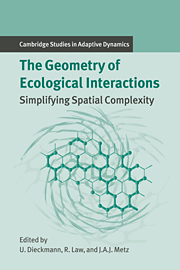Book contents
- Frontmatter
- Contents
- Contributing Authors
- 1 Introduction
- Part A Empirical and Statistical Background: A Plant Ecological Perspective
- Part B When the Mean-field Approximation Breaks Down
- Part C Simplifying Spatial Complexity: Examples
- Part D Simplifying Spatial Complexity: Techniques
- Introduction to Part D
- 18 Pair Approximations for Lattice-based Ecological Models
- 19 Pair Approximations for Different Spatial Geometries
- 20 Moment Methods for Ecological Processes in Continuous Space
- 21 Relaxation Projections and the Method of Moments
- 22 Methods for Reaction–Diffusion Models
- 23 The Dynamics of Invasion Waves
- 24 Epilogue
- References
- Index
- International Institute for Applied Systems Analysis
23 - The Dynamics of Invasion Waves
Published online by Cambridge University Press: 14 January 2010
- Frontmatter
- Contents
- Contributing Authors
- 1 Introduction
- Part A Empirical and Statistical Background: A Plant Ecological Perspective
- Part B When the Mean-field Approximation Breaks Down
- Part C Simplifying Spatial Complexity: Examples
- Part D Simplifying Spatial Complexity: Techniques
- Introduction to Part D
- 18 Pair Approximations for Lattice-based Ecological Models
- 19 Pair Approximations for Different Spatial Geometries
- 20 Moment Methods for Ecological Processes in Continuous Space
- 21 Relaxation Projections and the Method of Moments
- 22 Methods for Reaction–Diffusion Models
- 23 The Dynamics of Invasion Waves
- 24 Epilogue
- References
- Index
- International Institute for Applied Systems Analysis
Summary
Introduction
In this chapter we concentrate on certain macroscopic patterns in the transient behavior of spatially extended ecological systems. Chapters 17 and 22 on reaction–diffusion equations also deal with the macroscopic perspective, but from a different angle. Those chapters forego realistic movement and life-history detail in order to concentrate on interactions between individuals. In this chapter, we restrict ourselves to phenomena that are, in general, only weakly dependent on those interactions to arrive at robust and simple quantitative population-level predictions based on measurements of behavioral characteristics of individuals. Luckily, as Chapter 16 makes clear, such phenomena are not confined to the realm of mathematics, but commonly occur in real ecological systems as well.
Transient behavior is usually viewed as an effect of a temporary external perturbation of an otherwise stationary situation. From a biological perspective there are two principal types of perturbations. The first type are abiotic perturbations, such as an unusually severe drought; these usually affect large regions, leaving the spatial distributions of species macroscopically homogeneous. The other type of perturbation is the introduction of a new species or the occurrence of an advantageous mutation in an already established species. Such perturbations originate locally and from the initial inoculum spread over space in a wavelike manner. It is the second type of transient behavior that we consider here.
An invasion generally starts with the arrival of a small number of individuals of a new species or a mutation in a single individual. Thus the initial phase of an invasion is dominated by demographic stochasticity.
- Type
- Chapter
- Information
- The Geometry of Ecological InteractionsSimplifying Spatial Complexity, pp. 482 - 512Publisher: Cambridge University PressPrint publication year: 2000
- 9
- Cited by



